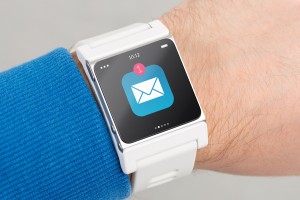Apple Inc. (NASDAQ:AAPL) is quite likely to release the iWatch smartwatch sometime this year, though of course there can be no certainty until the first units are on the shelves. Samsung has already beaten the Cupertino enterprise to the punch with its Galaxy Gear. The question is how much sales traction Apple’s entry in the smartwatch category will generate, and whether it is a game changer or a minor, secondary product that is little more than a thought experiment by Tim Cook and Jony Ive that has turned tangible.
The Samsung Galaxy Gear provides something of a test bed for smartphone popularity overall. In the first two months after its release, the smartphone, according to reports by Reuters, sold approximately 800,000 units worldwide, of which 50,000 were sold in South Korea. Though these figures appear robust, they may be skewed by the fact that the smartwatch was bundled with other electronics products, or even given away free as a reward for buying a Galaxy Note 3.
 Using the Gear as a free promotion like a toaster or a set of napkin rings suggests that demand might have been more listless than Samsung’s rosy press releases claim. This view is supported somewhat by the results of a Piper Jaffray poll. This survey revealed that only about 4 percent, or 1 in 25, of iPhone owners would be interested in purchasing an iWatch. Should the statistic hold broadly true, a maximum of 10 million units would be moved globally in the first year – by no means a disaster, but scarcely a game-changer for Apple Inc. (AAPL) either.
Using the Gear as a free promotion like a toaster or a set of napkin rings suggests that demand might have been more listless than Samsung’s rosy press releases claim. This view is supported somewhat by the results of a Piper Jaffray poll. This survey revealed that only about 4 percent, or 1 in 25, of iPhone owners would be interested in purchasing an iWatch. Should the statistic hold broadly true, a maximum of 10 million units would be moved globally in the first year – by no means a disaster, but scarcely a game-changer for Apple Inc. (AAPL) either.
Other analysts are more optimistic about the iWatch’s prospects, including those on Seeking Alpha. These analysts posit that the iWatch could reach penetration equal to that of iPhones by 2020, leading to 7 to 8 million sales of the device within American borders in the first year and 100 million in the U.S. alone by 2020. This appears to be a bold assertion, considering this would mean every third individual of every age in America would buy one of the watches. Even if the U.S. population expands notably by then, a full 25 percent of citizens owning one would be needed to achieve these figures.
A more realistic stance would be to predict modest though acceptable sales for the iWatch, with a small percent chance that it will prove to be a “dark horse,” with unexpectedly massive sales making it the next fad item. A lot will depend on its specific functionality, and how narrowly it is focused on fitness, which would necessarily cramp its market appeal. However, regardless of precise sales, the iWatch represents the advance of wearable technology, and is therefore an important product. Even if its sales are uninspiring, it will serve as the springboard for new innovations and further advances in miniaturization of practical mobile devices.



